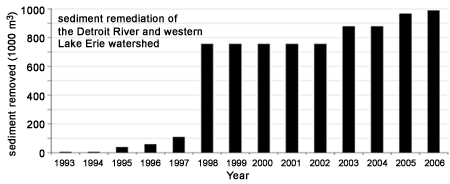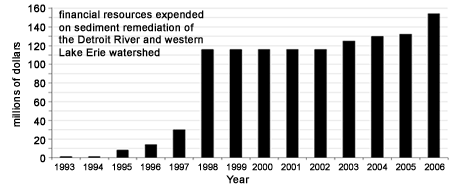Detroit River-Western Lake Erie Basin Indicator Project
Contaminated Sediment Remediation
Background
Although contaminant loads to Detroit River and Lake Erie from fixed sources have substantially decreased since the 1970s, the atmosphere and sediments continue to contribute contaminants to the ecosystem (Zarull et al. 2001). Since all Areas of Concern around Lake Erie (i.e., the Detroit River, Rouge River, River Raisin, and Maumee River) have contaminated sediment, it is viewed as a universal obstacle in restoring beneficial uses in the Detroit River and Lake Erie (Sediment Priority Action Committee, International Joint Commission 1999).
Detroit River and western Lake Erie have contaminants, such as mercury and PCB, in sediment that exceed chemical guidelines. The effects these contaminants are having on the ecosystem are only partially known. However, there is evidence linking these contaminants to restrictions on fish and wildlife consumption, fish tumors or other deformities, loss of fish and wildlife habitat, degraded invertebrate communities, and other beneficial use impairments identified in the U.S.-Canada Great Lakes Water Quality Agreement.
In general, reductions in contaminant loadings have resulted in a 50-70% decline in contamination of fish. However, consumption advisories on certain fishes remain in effect in Detroit River and Western Lake Erie. Since the mid-1980s, levels of contaminants in the environment appear to have generally leveled off or their rate of decrease has slowed substantially.
Status and Trends
Considerable progress has been made in sediment remediation in the watershed of the Detroit River and western Lake Erie over the last 13 years. For example, during 1993-2006 over 989,000 cubic meters of contaminated sediment has been remediated (Figure 1) as a result of 12 projects which include: Elizabeth Park Marina on Trenton Channel, Carter Industrial Site in Detroit, Lower River Raisin in Monroe, Evan's Ditch on Rouge River, Monguagon Creek in Riverview, Lower River Raisin floodplain in Monroe, Newburgh Lake impoundment on Rouge River, Willow Run Creek on Huron River, Fraleigh Creek on Ottawa River, Conner Creek on upper Detroit River, Black Lagoon on Trenton Channel, and Trenton Channel in Riverview. Examples of the magnitude and benefits of contaminated sediment remediation projects completed include:
- in 1998 approximately 306,000 cubic meters of contaminated sediment were removed from Newburgh Lake impoundment on the Rouge River at a cost of $11 million, resulting in a ten-fold decline in PCB contamination of fish and a lifting of the health advisory on fish from Newburgh Lake;
- in 2003 approximately 122,300 cubic meters of contaminated sediment were removed from Conner Creek at the upstream end of the Detroit River at a cost of $9 million, resulting in substantial environmental, aesthetic, and economic benefits; and
- in 2005 approximately 87,900 cubic meters of contaminated sediment were removed from Black Lagoon on the Detroit River at a cost of $9.3 million, furthering economic revitalization of the adjacent area.

Figure 1. The cumulative volume of sediment remediated from the Detroit River and western Lake Erie watershed, 1993-2006.
The cumulative cost of these 12 sediment remediation projects undertaken in the Detroit River-western Lake Erie watershed during 1993-2006 was over $154 million (Figure 2).

Figure 2. The cumulative financial resources expended on sediment remediation from the Detroit River and western Lake Erie watershed, 1993-2006.
Management Next Steps
Control of contaminants at source remains the primary imperative for action, but a higher priority must be given to measuring and monitoring both loadings and system responses.
Remediation of contaminated sediment is growing in importance as greater levels of source control are achieved. Sediment depositional zones have been delineated and thoroughly assessed in the Detroit River-western Lake Erie basin. The Michigan Department of Environmental Quality (Ostaszewski 2003) has concluded that there remains approximately 2.3 million cubic meters (3 million cubic yards) of sediments that impair beneficial uses in the Detroit River (in particular the Trenton Channel), Rouge River (from the turning basin downstream), and River Raisin (lower river) combined. In addition, EPA (Czeczele 2003) has concluded that additional sediment remediation is essential in the lower Ottawa River for the removal of fish consumption advisories.
Research/Monitoring Needs
There are gaps in our understanding of the relationship between contaminated sediment and the 11 beneficial use impairments identified in the Great Lakes Water Quality Agreement. As a result of these critical knowledge gaps, the International Joint Commission's Sediment Priority Action Committee (1999) recommended additional research to quantify the relationships between contaminated sediment and known use impairments, and to forecast ecological benefits. It was also recommended that ecological recovery and beneficial use restoration be monitored in a scientifically defensible and cost-effective fashion. In particular, much greater emphasis should be placed on post-project monitoring of effectiveness of sediment remediation (i.e., assessment of effectiveness relative to restoration of beneficial uses, with appropriate quality assurance/quality control).
References
- Czeczele, M. 2003. A Summary of Ottawa River PCB Investigations and Cleanup of Fraleigh Creek. In, Heidtke, T.M., J.H. Hartig, and B. Yu. Evaluating Ecosystem Results of PCB Control Measures within the Detroit River/Western Lake Erie Basin. U.S. Environmental Protection Agency, EPA-905-R-03-001, Chicago, Illinois.
- Ostaszewski, A. 2003. PCBs in Sediments: A Remedial Action Plan Perspective. In, Heidtke, T.M., J.H. Hartig, and B. Yu. Evaluating Ecosystem Results of PCB Control Measures within the Detroit River/Western Lake Erie Basin. U.S. Environmental Protection Agency, EPA-905-R-03-001, Chicago, Illinois.
- Sediment Priority Action Committee. 1999. Ecological benefits of contaminated sediment remediation in the Great Lakes Basin. Great Lakes Water Quality Board, International Joint Commission, Windsor, Ontario, Canada.
- Zarull, M.A., J.H. Hartig, and G. Krantzberg. 2001. Contaminated sediment remediation in the Laurentian Great Lakes: An overview. Water Qual. Res. J. Canada 36(2): 347-365.
Contact Information regarding Contaminated Sediment Remediation
Michael A. Zarull
Environment CanadaE-mail: Michael.Zarull@ec.gc.ca
John H. Hartig
U.S. Fish and Wildlife ServiceE-mail: John_Hartig@fws.gov
Lena Cicchelli
Wayne State UniversityE-mail: aq1875@wayne.edu